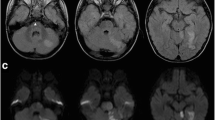Summary
Basilar artery occlusion (BAO) causing brainstem infarction occurred in a 7-year-old boy without any basic disorders. A diagnosis of BAO due to basilar artery dissection (BAD) was suspected at angiography, and this was confirmed by gadolinium-enhanced magnetic resonance imaging (MRI). These investigations clearly showed all the typical diagnostic signs such as a pseudolumen, double lumen and intimal flap, and a pseudolumen in resolution. The spontaneous healing of the dissection was clearly demonstrated during 10 months of follow-up. We stress that BAD can occur in young children and that combined diagnosis with gadolinium-enhanced MRI and angiography is conclusive for diagnosis of dissecting aneurysms. Wider use of these combined diagnostic methods will allow the detection of less severe basilar artery dissection, thus extending the spectrum of presentation and prognosis.
Similar content being viewed by others
Author information
Authors and Affiliations
Rights and permissions
About this article
Cite this article
Nakatomi, H., Nagata, K., Kawamoto, S. et al. Basilar Artery Occlusion due to Spontaneous Basilar Artery Dissection in a Child. Acta Neurochir (Wien) 141, 99–104 (1999). https://doi.org/10.1007/s007010050272
Issue Date:
DOI: https://doi.org/10.1007/s007010050272




